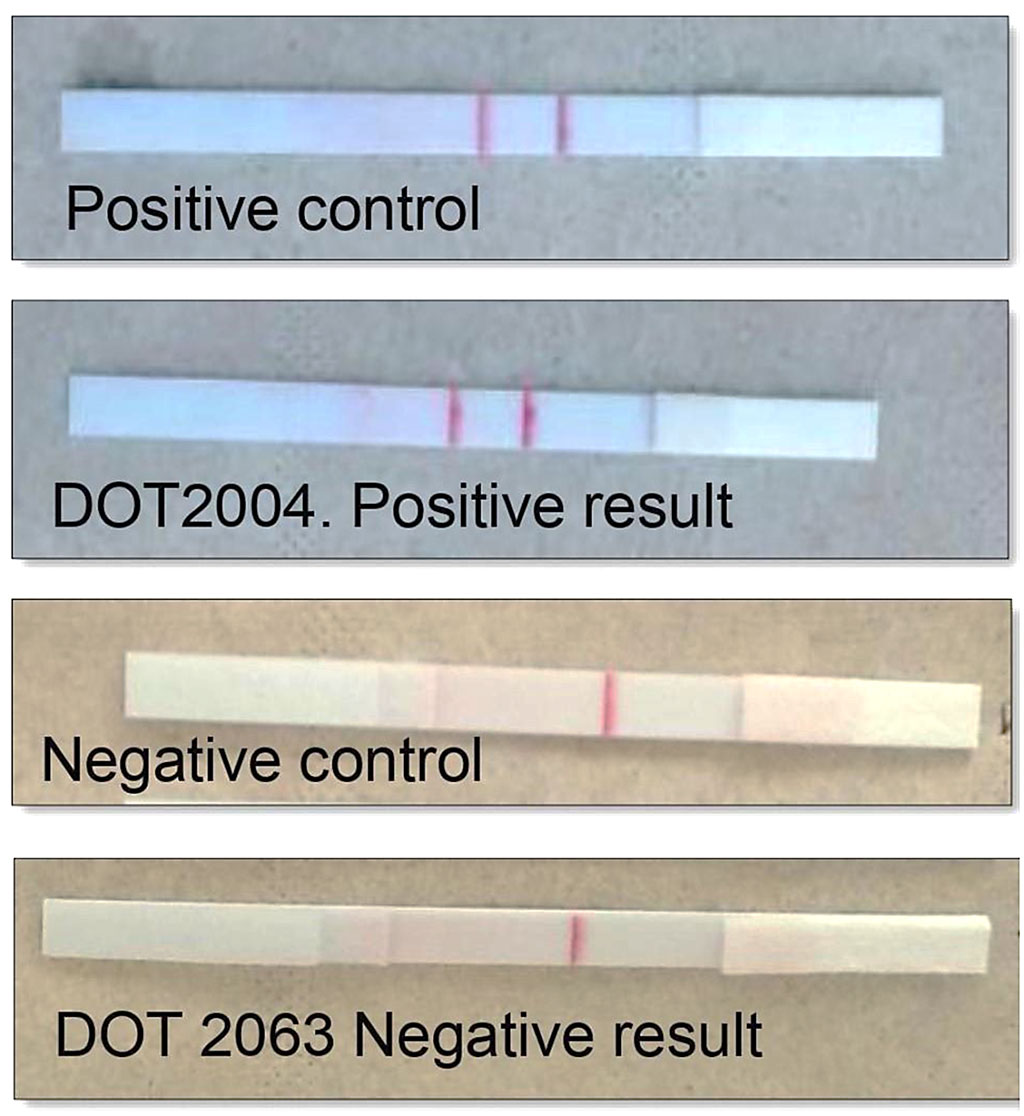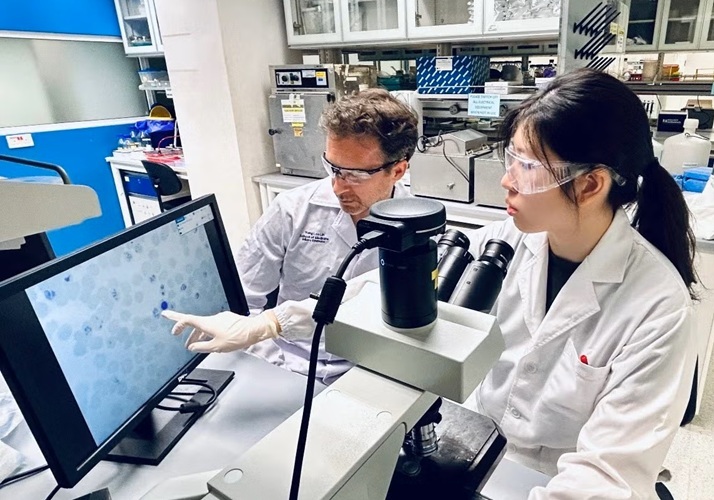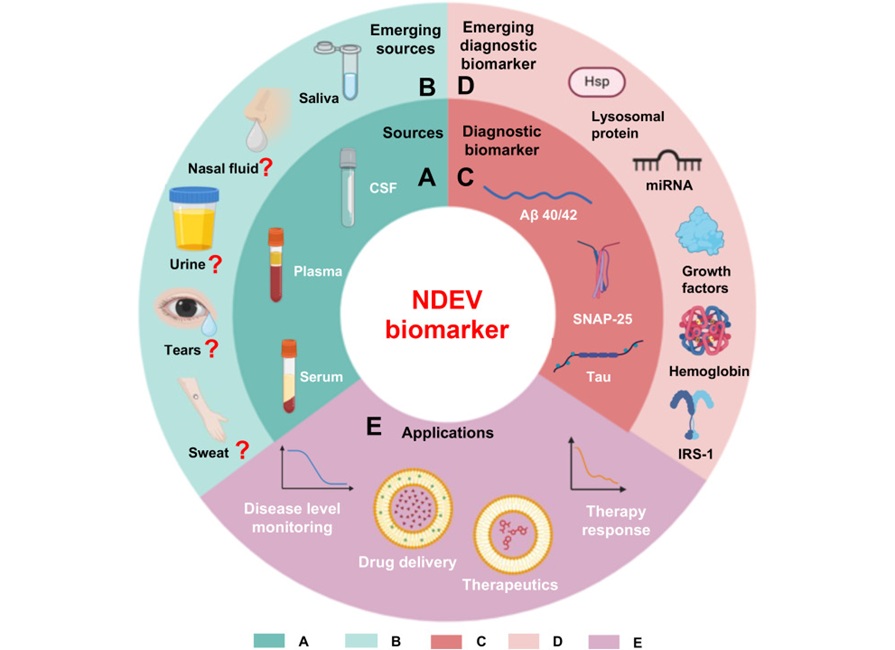RPA-LF Assay Evaluated for Cutaneous Leishmaniasis in Colombia
|
By LabMedica International staff writers Posted on 17 May 2021 |

Image: Results of the Recombinase Polymerase Amplification-Lateral Flow (RPA-LF) assay for cutaneous leishmaniasis (Photo courtesy of University of Texas Medical Branch)
Cutaneous leishmaniasis (CL) is a recognized public health challenge in the Americas, with an average of 55,000 cases per year between 2001 and 2018 in 17 countries of the region. Most cases (79.4%) have been acquired in and continue to occur in rural areas.
Currently available diagnostic methods for CL have several limitations. Light microscopic analysis of smears obtained from cutaneous lesions is the most commonly used diagnostic method for CL because of its low cost, yet its sensitivity varies widely depending on the experience and skill of the operator. In addition, sensitivity of microscopy is diminished in lesions of longer duration in chronic lesions with their notorious low parasite burden.
A team of tropical medicine specialists from the University of Texas Medical Branch (Galveston, TX, USA) and the Universidad Icesi (Cali, Colombia) conducted a cross-sectional study of diagnostic test performance between January 2018 and July 2019. There were 118 participants ≥2 years of age, with ulcerated skin lesions of more than two weeks’ duration were eligible and enrolled consecutively either in their residence (in rural Tumaco) by community health workers, or when seeking care at the primary health facility in urban Tumaco or the reference center laboratory in Cali.
The team utilized a composite “gold standard” based on microscopy of lesion smear, culture, histopathology of biopsy and qPCR18S as a reference. Minimally invasive swab and FTA filter paper samples were obtained by community health workers and highly trained technicians from ulcerated lesions. The investigators evaluated the diagnostic test performance of Isothermal Recombinase Polymerase Amplification (RPA) targeting Leishmania kinetoplast DNA, coupled with a lateral flow (LF) immunochromatographic strip, in a field setting and a laboratory reference center.
The scientists reported that the sensitivity and specificity of RPA-LF in the reference lab scenario were 87% (95%CI 74–94) and 86% (95%CI 74–97), respectively. In the field scenario, the sensitivity was 75% (95%CI 65–84) and specificity 89% (95%CI 78–99). Positive likelihood ratios in both scenarios were higher than six while negative likelihood ratios ranged to 0.2–0.3 supporting the usefulness of RPA-LF to rule-in and potentially to rule-out infection.
The authors concluded that RPA-LF is a valid, efficacious test to diagnose CL that could replace or complement microscopy in rural areas. Its combination with non-invasive sampling and low complexity requirements for processing and interpreting results position this test as an achievable alternative for diagnosis of CL at points of care in Colombia. The study was published on April 28, 2021 in the journal PLOS Neglected Tropical Diseases.
Related Links:
University of Texas Medical Branch
Universidad Icesi
Currently available diagnostic methods for CL have several limitations. Light microscopic analysis of smears obtained from cutaneous lesions is the most commonly used diagnostic method for CL because of its low cost, yet its sensitivity varies widely depending on the experience and skill of the operator. In addition, sensitivity of microscopy is diminished in lesions of longer duration in chronic lesions with their notorious low parasite burden.
A team of tropical medicine specialists from the University of Texas Medical Branch (Galveston, TX, USA) and the Universidad Icesi (Cali, Colombia) conducted a cross-sectional study of diagnostic test performance between January 2018 and July 2019. There were 118 participants ≥2 years of age, with ulcerated skin lesions of more than two weeks’ duration were eligible and enrolled consecutively either in their residence (in rural Tumaco) by community health workers, or when seeking care at the primary health facility in urban Tumaco or the reference center laboratory in Cali.
The team utilized a composite “gold standard” based on microscopy of lesion smear, culture, histopathology of biopsy and qPCR18S as a reference. Minimally invasive swab and FTA filter paper samples were obtained by community health workers and highly trained technicians from ulcerated lesions. The investigators evaluated the diagnostic test performance of Isothermal Recombinase Polymerase Amplification (RPA) targeting Leishmania kinetoplast DNA, coupled with a lateral flow (LF) immunochromatographic strip, in a field setting and a laboratory reference center.
The scientists reported that the sensitivity and specificity of RPA-LF in the reference lab scenario were 87% (95%CI 74–94) and 86% (95%CI 74–97), respectively. In the field scenario, the sensitivity was 75% (95%CI 65–84) and specificity 89% (95%CI 78–99). Positive likelihood ratios in both scenarios were higher than six while negative likelihood ratios ranged to 0.2–0.3 supporting the usefulness of RPA-LF to rule-in and potentially to rule-out infection.
The authors concluded that RPA-LF is a valid, efficacious test to diagnose CL that could replace or complement microscopy in rural areas. Its combination with non-invasive sampling and low complexity requirements for processing and interpreting results position this test as an achievable alternative for diagnosis of CL at points of care in Colombia. The study was published on April 28, 2021 in the journal PLOS Neglected Tropical Diseases.
Related Links:
University of Texas Medical Branch
Universidad Icesi
Latest Microbiology News
- New UTI Diagnosis Method Delivers Antibiotic Resistance Results 24 Hours Earlier
- Breakthroughs in Microbial Analysis to Enhance Disease Prediction
- Blood-Based Diagnostic Method Could Identify Pediatric LRTIs
- Rapid Diagnostic Test Matches Gold Standard for Sepsis Detection
- Rapid POC Tuberculosis Test Provides Results Within 15 Minutes
- Rapid Assay Identifies Bloodstream Infection Pathogens Directly from Patient Samples
- Blood-Based Molecular Signatures to Enable Rapid EPTB Diagnosis
- 15-Minute Blood Test Diagnoses Life-Threatening Infections in Children
- High-Throughput Enteric Panels Detect Multiple GI Bacterial Infections from Single Stool Swab Sample
- Fast Noninvasive Bedside Test Uses Sugar Fingerprint to Detect Fungal Infections
- Rapid Sepsis Diagnostic Device to Enable Personalized Critical Care for ICU Patients
- Microfluidic Platform Assesses Neutrophil Function in Sepsis Patients
- New Diagnostic Method Confirms Sepsis Infections Earlier
- New Markers Could Predict Risk of Severe Chlamydia Infection
- Portable Spectroscopy Rapidly and Noninvasively Detects Bacterial Species in Vaginal Fluid
- CRISPR-Based Saliva Test Detects Tuberculosis Directly from Sputum
Channels
Clinical Chemistry
view channel
Compact Raman Imaging System Detects Subtle Tumor Signals
Accurate cancer diagnosis often depends on labor-intensive tissue staining and expert pathological review, which can delay results and limit access to rapid screening. These conventional methods also make... Read more
Noninvasive Blood-Glucose Monitoring to Replace Finger Pricks for Diabetics
People with diabetes often need to measure their blood glucose multiple times a day, most commonly through finger-prick blood tests or implanted sensors. These methods can be painful, inconvenient, and... Read moreMolecular Diagnostics
view channel
Genomic Test Identifies African Americans at Risk for Early Prostate Cancer Recurrence
Prostate cancer is one of the most commonly diagnosed cancers in men and a leading cause of cancer-related death, particularly in the United States. African American men face a disproportionately higher... Read more
Blood Test Could Identify Biomarker Signature of Cerebral Malaria
Malaria remains a major cause of death and long-term disability in many low- and middle-income countries, with around 600,000 deaths reported globally each year. The most severe form, cerebral malaria,... Read moreHematology
view channel
MRD Tests Could Predict Survival in Leukemia Patients
Acute myeloid leukemia is an aggressive blood cancer that disrupts normal blood cell production and often relapses even after intensive treatment. Clinicians currently lack early, reliable markers to predict... Read more
Platelet Activity Blood Test in Middle Age Could Identify Early Alzheimer’s Risk
Early detection of Alzheimer’s disease remains one of the biggest unmet needs in neurology, particularly because the biological changes underlying the disorder begin decades before memory symptoms appear.... Read more
Microvesicles Measurement Could Detect Vascular Injury in Sickle Cell Disease Patients
Assessing disease severity in sickle cell disease (SCD) remains challenging, especially when trying to predict hemolysis, vascular injury, and risk of complications such as vaso-occlusive crises.... Read more
ADLM’s New Coagulation Testing Guidance to Improve Care for Patients on Blood Thinners
Direct oral anticoagulants (DOACs) are one of the most common types of blood thinners. Patients take them to prevent a host of complications that could arise from blood clotting, including stroke, deep... Read moreImmunology
view channel
Ultrasensitive Liquid Biopsy Demonstrates Efficacy in Predicting Immunotherapy Response
Immunotherapy has transformed cancer treatment, but only a small proportion of patients experience lasting benefit, with response rates often remaining between 10% and 20%. Clinicians currently lack reliable... Read more
Blood Test Could Identify Colon Cancer Patients to Benefit from NSAIDs
Colon cancer remains a major cause of cancer-related illness, with many patients facing relapse even after surgery and chemotherapy. Up to 40% of people with stage III disease experience recurrence, highlighting... Read morePathology
view channel
Genetics and AI Improve Diagnosis of Aortic Stenosis
Aortic stenosis is a progressive narrowing of the aortic valve that restricts blood flow from the heart and can be fatal if left untreated. There are currently no medical therapies that can prevent or... Read more
AI Tool Simultaneously Identifies Genetic Mutations and Disease Type
Interpreting genetic test results remains a major challenge in modern medicine, particularly for rare and complex diseases. While existing tools can indicate whether a genetic mutation is harmful, they... Read more
Rapid Low-Cost Tests Can Prevent Child Deaths from Contaminated Medicinal Syrups
Medicinal syrups contaminated with toxic chemicals have caused the deaths of hundreds of children worldwide, exposing a critical gap in how these products are tested before reaching patients.... Read more
Tumor Signals in Saliva and Blood Enable Non-Invasive Monitoring of Head and Neck Cancer
Head and neck cancers are among the most aggressive malignancies worldwide, with nearly 900,000 new cases diagnosed each year. Monitoring these cancers for recurrence or relapse typically relies on tissue... Read moreTechnology
view channel
AI Predicts Colorectal Cancer Survival Using Clinical and Molecular Features
Colorectal cancer is one of the most common and deadly cancers worldwide, and accurately predicting patient survival remains a major clinical challenge. Traditional prognostic tools often rely on either... Read more
Diagnostic Chip Monitors Chemotherapy Effectiveness for Brain Cancer
Glioblastoma is one of the most aggressive and fatal brain cancers, with most patients surviving less than two years after diagnosis. Treatment is particularly challenging because the tumor infiltrates... Read moreIndustry
view channel
BD and Penn Institute Collaborate to Advance Immunotherapy through Flow Cytometry
BD (Becton, Dickinson and Company, Franklin Lakes, NJ, USA) has entered into a strategic collaboration with the Institute for Immunology and Immune Health (I3H, Philadelphia, PA, USA) at the University... Read more



















